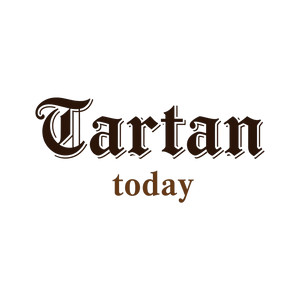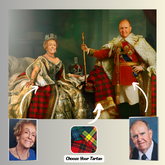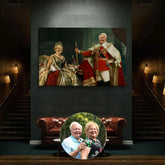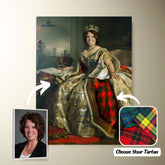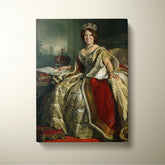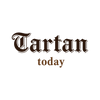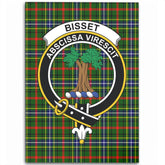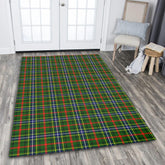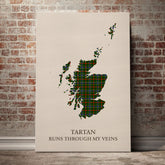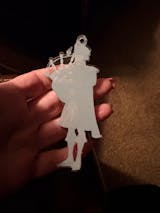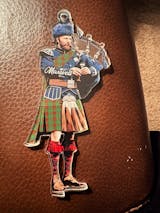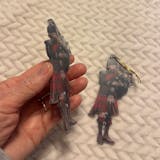-
Personalized Clan Bisset Modern Clan Crest Tartan Santa Ornament – Custom Acrylic Christmas Decoration LT55 - Bisset
Personalized Clan Bisset Modern Clan Badge Tartan Ornament – Custom Acrylic Christmas Decoration LT55Celebrate your Scottish heritage with this unique wood & acrylic tartan ornament. Perfect as a personalized Christmas decoration or a meaningful gift for friends and relatives on special occasions such as...- From $19.99 USD
- From $19.99 USD
- Unit price
- per
-
Bisset
-
Personalized Clan Bisset Tartan Drummer Ornament with Custom Name – Scottish Christmas Tree Decoration XX59
Personalized Clan Bisset Tartan Drummer Ornament with Custom Name – Scottish Christmas Tree Decoration XX59Celebrate your Scottish heritage with this unique wood & acrylic tartan ornament. Perfect as a personalized Christmas decoration or a meaningful gift for friends and relatives on special occasions such...- From $19.99 USD
$25.99 USD- From $19.99 USD
- Unit price
- per
Save $6.00 -
Personalized Clan Bisset 2 Tartan Drummer Ornament with Custom Name – Scottish Christmas Tree Decoration DZ37
Personalized Clan Bisset 2 Tartan Drummer Ornament with Custom Name – Scottish Christmas Tree Decoration DZ37Celebrate your Scottish heritage with this unique wood & acrylic tartan ornament. Perfect as a personalized Christmas decoration or a meaningful gift for friends and relatives on special occasions...- From $19.99 USD
$25.99 USD- From $19.99 USD
- Unit price
- per
Save $6.00 -
Personalized Clan Bisset Tartan Bagpipe Ornament with Custom Name – Scottish Christmas Tree Decoration CA39
Personalized Clan Bisset Tartan Bagpipe Ornament with Custom Name – Scottish Christmas Tree Decoration CA39Celebrate your Scottish heritage with this unique wood & acrylic tartan ornament. Perfect as a personalized Christmas decoration or a meaningful gift for friends and relatives on special occasions such...- From $19.99 USD
$25.99 USD- From $19.99 USD
- Unit price
- per
Save $6.00 -
Personalized Clan Bisset Reproduction Tartan Bagpipe Ornament with Custom Name – Scottish Christmas Tree Decoration EW26
Personalized Clan Bisset Reproduction Tartan Bagpipe Ornament with Custom Name – Scottish Christmas Tree Decoration EW26Celebrate your Scottish heritage with this unique wood & acrylic tartan ornament. Perfect as a personalized Christmas decoration or a meaningful gift for friends and relatives on special occasions...- From $19.99 USD
$25.99 USD- From $19.99 USD
- Unit price
- per
Save $6.00 -
Personalized Clan Bisset Modern Tartan Bagpipe Ornament with Custom Name – Scottish Christmas Tree Decoration EU65
Personalized Clan Bisset Modern Tartan Bagpipe Ornament with Custom Name – Scottish Christmas Tree Decoration EU65Celebrate your Scottish heritage with this unique wood & acrylic tartan ornament. Perfect as a personalized Christmas decoration or a meaningful gift for friends and relatives on special occasions...- From $19.99 USD
$25.99 USD- From $19.99 USD
- Unit price
- per
Save $6.00 -
Personalized Clan Bisset Ancient Tartan Bagpipe Ornament with Custom Name – Scottish Christmas Tree Decoration DH60
Personalized Clan Bisset Ancient Tartan Bagpipe Ornament with Custom Name – Scottish Christmas Tree Decoration DH60Celebrate your Scottish heritage with this unique wood & acrylic tartan ornament. Perfect as a personalized Christmas decoration or a meaningful gift for friends and relatives on special occasions...- From $19.99 USD
$25.99 USD- From $19.99 USD
- Unit price
- per
Save $6.00 -
Personalized Clan Bisset 2 Tartan Bagpipe Ornament with Custom Name – Scottish Christmas Tree Decoration CX46
Personalized Clan Bisset 2 Tartan Bagpipe Ornament with Custom Name – Scottish Christmas Tree Decoration CX46Celebrate your Scottish heritage with this unique wood & acrylic tartan ornament. Perfect as a personalized Christmas decoration or a meaningful gift for friends and relatives on special occasions...- From $19.99 USD
$25.99 USD- From $19.99 USD
- Unit price
- per
Save $6.00 -
Personalized Clan Bisset #2 Reproduction Tartan Bagpipe Ornament with Custom Name – Scottish Christmas Tree Decoration IH29
Personalized Clan Bisset #2 Reproduction Tartan Bagpipe Ornament with Custom Name – Scottish Christmas Tree Decoration IH29Celebrate your Scottish heritage with this unique wood & acrylic tartan ornament. Perfect as a personalized Christmas decoration or a meaningful gift for friends and relatives on special...- From $19.99 USD
$25.99 USD- From $19.99 USD
- Unit price
- per
Save $6.00 -
Personalized Clan Bisset #2 Modern Tartan Bagpipe Ornament with Custom Name – Scottish Christmas Tree Decoration UV81
Personalized Clan Bisset #2 Modern Tartan Bagpipe Ornament with Custom Name – Scottish Christmas Tree Decoration UV81Celebrate your Scottish heritage with this unique wood & acrylic tartan ornament. Perfect as a personalized Christmas decoration or a meaningful gift for friends and relatives on special...- From $19.99 USD
$25.99 USD- From $19.99 USD
- Unit price
- per
Save $6.00 -
Personalized Clan Bisset #2 Ancient Tartan Bagpipe Ornament with Custom Name – Scottish Christmas Tree Decoration NS38
Personalized Clan Bisset #2 Ancient Tartan Bagpipe Ornament with Custom Name – Scottish Christmas Tree Decoration NS38Celebrate your Scottish heritage with this unique wood & acrylic tartan ornament. Perfect as a personalized Christmas decoration or a meaningful gift for friends and relatives on special...- From $19.99 USD
$25.99 USD- From $19.99 USD
- Unit price
- per
Save $6.00 -
Personalized Clan Bisset Tartan Bagpipe Ornament with Custom Name – Scottish Christmas Tree Decoration FJ82
Personalized Clan Bisset Tartan Bagpipe Ornament with Custom Name – Scottish Christmas Tree Decoration FJ82Celebrate your Scottish heritage with this unique wood & acrylic tartan ornament. Perfect as a personalized Christmas decoration or a meaningful gift for friends and relatives on special occasions such...- From $19.99 USD
$25.99 USD- From $19.99 USD
- Unit price
- per
Save $6.00 -
Personalized Clan Bisset 2 Tartan Bagpipe Ornament with Custom Name – Scottish Christmas Tree Decoration PW57
Personalized Clan Bisset 2 Tartan Bagpipe Ornament with Custom Name – Scottish Christmas Tree Decoration PW57Celebrate your Scottish heritage with this unique wood & acrylic tartan ornament. Perfect as a personalized Christmas decoration or a meaningful gift for friends and relatives on special occasions...- From $19.99 USD
$25.99 USD- From $19.99 USD
- Unit price
- per
Save $6.00 -
Personalized Clan Bisset Weathered Clan Crest Tartan Santa Ornament – Custom Acrylic Christmas Decoration FG30 - Bisset
Personalized Clan Bisset Weathered Clan Badge Tartan Ornament – Custom Acrylic Christmas Decoration FG30Celebrate your Scottish heritage with this unique wood & acrylic tartan ornament. Perfect as a personalized Christmas decoration or a meaningful gift for friends and relatives on special occasions such as...- From $19.99 USD
- From $19.99 USD
- Unit price
- per
-
Bisset
-
Clan Bisset Tartan Crest Rug – Scottish Highland Carpet for Living Room, Celtic Home Decor & Scotland Gift PS90
Clan Bisset Tartan Crest Rug – Scottish Highland Carpet for Living Room, Celtic Home Decor & Scotland Gift PS90Bring timeless Scottish charm into your home with our premium Tartan Area Rug. Designed with authentic Scottish tartan patterns, this rug is perfect for adding a...- From $58.45 USD
- From $58.45 USD
- Unit price
- per
-
Clan Bisset Tartan Rug – Scottish Highland Carpet for Living Room, Celtic Home Decor & Scotland Gift DI49
Clan Bisset Tartan Rug – Scottish Highland Carpet for Living Room, Celtic Home Decor & Scotland Gift DI49Bring timeless Scottish charm into your home with our premium Tartan Area Rug. Designed with authentic Scottish tartan patterns, this rug is perfect for adding a touch...- From $58.45 USD
- From $58.45 USD
- Unit price
- per
-
Custom Name Clan Bisset 2 Tartan Garden Flag with Clan Crest and the Golden Sword of Courageous Legacy GZ67 - Bisset 2
Custom Name Clan Bisset 2 Tartan Garden Flag with Clan Crest and the Golden Sword of Courageous Legacy GZ67 Immerse your space in the rich heritage of Scotland with our Tartan Garden Flags, exclusively from Tartan Today. Featuring vibrant tartan and Scottish heritage designs, these...- From $34.45 USD
- From $34.45 USD
- Unit price
- per
-
Bisset 2
-
Custom Name Clan Bisset 1 Tartan Garden Flag with Clan Crest and the Golden Sword of Courageous Legacy SO91 - Bisset 1
Custom Name Clan Bisset 1 Tartan Garden Flag with Clan Crest and the Golden Sword of Courageous Legacy SO91 Immerse your space in the rich heritage of Scotland with our Tartan Garden Flags, exclusively from Tartan Today. Featuring vibrant tartan and Scottish heritage designs, these...- From $34.45 USD
- From $34.45 USD
- Unit price
- per
-
Bisset 1
-
Clan Bisset Tartan Scotland Map Canvas “Tartan Runs Through My Veins” Wall Art JI20
Clan Bisset Tartan Scotland Map Canvas “Tartan Runs Through My Veins” Wall Art JI20Celebrate your Scottish heritage with this striking canvas print featuring the map of Scotland filled with Bisset tartan, paired with the bold phrase: “Tartan Runs Through My Veins.” Whether you're honoring...- From $35.05 USD
- From $35.05 USD
- Unit price
- per
-
Clan Bisset 2 Tartan Scotland Map Canvas “Tartan Runs Through My Veins” Wall Art YE77
Clan Bisset 2 Tartan Scotland Map Canvas “Tartan Runs Through My Veins” Wall Art YE77Celebrate your Scottish heritage with this striking canvas print featuring the map of Scotland filled with Bisset 2 tartan, paired with the bold phrase: “Tartan Runs Through My Veins.” Whether...- From $35.05 USD
- From $35.05 USD
- Unit price
- per
Ex: Your Tartan + Product
Popular Products
Turn Me Royal Personalized Portrait from Your Photo, Custom Tartan. Custom Canvas Wall Art as Gift for Men
- From $32.45 USD
- From $32.45 USD
- Unit price
- / per
Royalty Couple Personalized Portrait from Your Photo, Custom Tartan. Custom Canvas Wall Art
- From $47.45 USD
- From $47.45 USD
- Unit price
- / per
The Queen Personalized Portrait from Your Photo, Custom Tartan. Custom Canvas Wall Art as Gift for Women
- From $32.45 USD
- From $32.45 USD
- Unit price
- / per
Which Clan Are You From?
List Of Tartan
-
Clan A
- Abercrombie Tartan
- Aberdeen Tartan
- Abernethy Tartan
- Adair Tartan
- Adam Tartan
- Ayrshire Tartan
- Agnew Tartan
- Aikenhead Tartan
- Ainslie Tartan
- Aiton Tartan
- Allan Tartan
- Alexander Tartan
- Allardice Tartan
- Allison Tartan
- Anderson Tartan
- Angus Tartan
- Anstruther Tartan
- Arbuthnot Tartan
- Armstrong Tartan
- Arnott Tartan
- Auchinleck Tartan
- Ayrshire Tartan
-
Clan B
- Baillie Tartan
- Bain Tartan
- Baird Tartan
- Balfour Tartan
- Bannatyne Tartan
- Bannerman Tartan
- Barclay Tartan
- Baxter Tartan
- Beaton Tartan
- Bell Tartan
- Belshes Tartan
- Bethune Tartan
- Beveridge Tartan
- Binning Tartan
- Bisset Tartan
- Blackadder Tartan
- Blackstock Tartan
- Black Watch Tartan
- Blair Tartan
- Blane Tartan
- Blyth Tartan
- Borthwick Tartan
- Boswell Tartan
- Bowie Tartan
- Boyd Tartan
- Boyle Tartan
- Brisbane Tartan
- Brodie Tartan
- Brown/ Broun Tartan
- Bruce Tartan
- Buccleuch Tartan
- Buchan Tartan
- Buchanan Tartan
- Burnett Tartan
- Burns Tartan
- Butter Tartan
- Byres Tartan
-
Clan C
- Cairns Tartan
- Calder Tartan
- Callander Tartan
- Cameron Tartan
- Campbell Tartan
- Campbell of Breadalbane Tartan
- Campbell of Cawdor Tartan
- Carmichael Tartan
- Carnegie Tartan
- Carruthers Tartan
- Cathcart Tartan
- Chalmers Tartan
- Charteris Tartan
- Chattan Tartan
- Cheyne Tartan
- Chisholm Tartan
- Christie Tartan
- Clark Tartan
- Clelland Tartan
- Clephan Tartan
- Clergy Tartan
- Cochrane Tartan
- Cockburn Tartan
- Colquhoun Tartan
- Colville Tartan
- Cooper Tartan
- Couper Tartan
- Craig Tartan
- Cranstoun Tartan
- Crawford Tartan
- Crichton Tartan
- Crief District Tartan
- Crosbie Tartan
- Cumming Tartan
- Cunningham Tartan
- Currie Tartan
- Clan D
- Clan E
- Clan F
- Clan G
- Clan H
- Clan I
- Clan J
- Clan K
- Clan L
-
Clan M
- Maitland Tartan
- Malcolm Tartan
- Mar Tartan
- Marjoribanks Tartan
- Maxtone Tartan
- Matheson Tartan
- Maule Tartan
- Maxwell Tartan
- Meldrum Tartan
- Melville Tartan
- Menzies Tartan
- Mercer Tartan
- Middleton Tartan
- Moffat Tartan
- Moncrieffe Tartan
- Montgomery Tartan
- Monypenny Tartan
- Moncreiffe Tartan
- Monteith Tartan
- Morrison Tartan
- Mouat Tartan
- Moubray Tartan
- Mow Tartan
- Muir_More Tartan
- Muirhead Tartan
- Munro Tartan
- Murray Tartan
- Murray of Atholl Tartan
-
Clan Mc/Mac
- MacAlister Tartan
- MacArthur Tartan
- MacAlpine Tartan
- MacAulay Tartan
- MacBain Tartan
- MacBean Tartan
- MacBeth Tartan
- MacCallum Tartan
- MacCraig Tartan
- MacColl Tartan
- MacCorquodale Tartan
- MacDiarmid Tartan
- MacDonald Tartan
- MacDonald of Clanranald Tartan
- MacDonald of Sleat Tartan
- MacDonnell of Glengarry Tartan
- MacDonnell of Keppoch Tartan
- MacDougall Tartan
- MacDowall Tartan
- MacDuff Tartan
- MacEwen_MacEwan Tartan
- MacEdward Tartan
- MacFarlane Tartan
- MacGill Tartan
- MacGillivray Tartan
- MacGregor Tartan
- MacGowan (McGowan) Tartan
- MacHardy Tartan
- MacIan Tartan
- MacInnes Tartan
- MacIntyre Tartan
- MacKay Tartan
- MacKillop Tartan
- MacKellar Tartan
- Mackinlay Tartan
- MacKenzie Tartan
- Mackie Tartan
- MacKinnon Tartan
- MacKintosh / MacIntosh Tartan
- MacLeod Tartan
- MacMillan Tartan
- MacNab Tartan
- MacNaughton Tartan
- MacNeil / MacNeill Tartan
- MacNeil of Colonsay Tartan
- MacNicol Tartan
- MacPhail Tartan
- MacPhee_MacFie Tartan
- MacPherson Tartan
- MacQuarrie Tartan
- MacQueen Tartan
- MacRae Tartan
- MacRow Tartan
- MacSporran Tartan
- MacTaggart Tartan
- MacTavish Tartan
- MacThomas Tartan
- McCorquodale Tartan
- McCulloch Tartan
- McFadzen Tartan
- McGeachie Tartan
- McIver Tartan
- McKerrell Tartan
- Clan N
- Clan O
- Clan P
- Clan R
-
Clan S
- Sandilands Tartan
- Scott Tartan
- Scrymgeour Tartan
- Selkirk Tartan
- Sempill Tartan
- Seton Tartan
- Shaw Tartan
- Shepherd Tartan
- Sinclair Tartan
- Skene Tartan
- Skirving Tartan
- Smith Tartan
- Somerville Tartan
- Spalding Tartan
- Spens Tartan
- Spottiswood Tartan
- Stevenson Tartan
- Stewart Tartan
- Stewart of Appin Tartan
- Stirling Tartan
- Strachan Tartan
- Straiton Tartan
- Strange Tartan
- Strathclyde District Tartan
- Stuart of Bute Tartan
- Sutherland Tartan
- Swinton Tartan
- Clan T
- Clan U W Y
- Request Your Clan
Clan Bisset (Bisset Tartan)
1. About Clan Bisset (Bisset Tartan)
2. Clan Bisset History (Bisset Tartan)
Henricus Byset, a witness to a William the Lion charter issued before to 1198, is the first person with this name to be mentioned in Scottish history.
His son, John Byset, was a witness to a charter signed by Henry de Graham in 1204 and was granted estates in the north by the king.
A Paisley charter was seen by Thomas de Bessat in 1204 and a yar super Leven was witnessed by William Bisseth in Alexander II's confirmation in 1224.
In 1226, Walter Biset attested to a charter by Alexander II relating to the collection of tolls at the Cross of Shettlestone, and in Brechin, in 1232, Walter Byseth and William Byset attested to a charter by Alexander II to Gylandris.
Following a Tournament that year in Haddington, the family's fortunes abruptly declined in 1242. The young Earl of Atholl badly outclassed Walter Byset, the lord of Aboyne.
By setting fire to the residence where the Earl was sleeping, Walter exacted retribution and killed him.
The bishop of Aberdeen excommunicated Walter and his nephew John Byset and banished them from the realm.
When Walter Biset passed away in 1251, his manor of Ulvington was found confiscated.
Alan, Earl of Atholl and Thomas's son, was pardoned for killing some of John Biset in Ireland the following year (1252)—likely as a continuation of the family rivalry.
When the bishop of Moray sought a judgment that three persons, Robert, Nevin, and Donald, were the natives and leige-men of the bishop, the church of Moray, and his land in 1364, Walter Buset of Lessendrum served as the replacement sheriff of Banff and presided over the court there.
Thomas Byssate had a tenement in Glasgow in 1486, while Jacobus Besat served as prior of St. Andrews in 1395.
Moray and Aberdeenshire still have a sizable Bisset population. The Lessendrum estate in Aberdeenshire was as the family's primary residence from the 13th century until 1981.
3. Clan Bisset Tartans
One of the first tartans created by the Scottish Tartans Society was the Bisset one. It belonged to a Mrs. E. Bisset. They desired that the colors stand for:
The shield of Bisset is blue and white.
The axe's woodchips gave off a yellow tint.
portraying the motto with black
Red represents the 'everlasting flame'
for the young, untouched growth, green
R/18 G36 K12 K6 Y6 G12 A6 W/6 Thread count
Bisset Tartan
The Bisset clan, which is a sept of these clans, can don the following tartans because the Bisset tartan is a unique weaving and not readily available:
Fraser Modern
Grant Modern
MacDonald Modern
4. Clan Bisset Crest & Coats of Arms
4.1 Clan Bisset Crest
Worn by all of the name and ancestry
4.2 Clan Bisset Coat of Arms
Note on Coats of Arms: A coat of arms is given to an individual under Scottish heraldic law (with the exception of civic or corporate arms). A 'family coat of arms' does not exist.
With the exclusions listed above, the weapons depicted below are personal weapons. The only person authorized to use these weapons is the grantee.
5. Clan Bisset Places & People
5.1 Charles Bisset (1717-1791)
Medical professional and military engineer Charles Bisset. He attended Edinburgh University to study medicine, and in 1740 he joined Admiral Vernon's fleet as a surgeon at the Military Hospital in Jamaica.
In 1745, he made his way back to England, and a year later, he joined the 42nd Highlanders as an Ensign.
In the course of the Wars of the Austrian Succession, he was tasked with compiling a report on the developments of the siege of Bergen-op-Zoom, a town that is today located in southern Holland and was assaulted by the French.
The siege culminated with the killing of the holding garrison.
Charles later worked as a doctor in Skelton, Yorkshire, after rising to the rank of "Engineer Extraordinary" in the Engineer Brigade.
He wrote numerous books on medical and fortification-related topics.
5.2 James Bisset (1762 – 1832)
The son of a trader who had experienced financial difficulty, James Bisset was born in Perth. He had his initial education at Perth Academy and then, at the age of 13, moved to Birmingham to live with his older brother, a more successful merchant.
He started as an apprentice japanner (the practice of ornamental painting on a black enamel base) at the age of 15 and later transitioned to painting miniatures. Due to his great success, he was able to advance socially and wed the local landowner's daughter.
In order to construct Birmingham's first art gallery, Bisset's business expanded to include the production of medals and the sale of fine art, and he was able to relocate to a spacious home on New Street.
Lord Nelson was one of several famous people who patronized the gallery. He moved to Leamington Spa after selling two expensive Canaletto paintings.
As a major participant in Birmingham's cultural and business life, a member of the Birmingham Book Club, and a poet, Bisset was well-known.
His 1800 Poetic survey round Birmingham, a "grand tour" of Birmingham trades at the period of the city's revolutionary industrial boom, is his most famous piece of writing. It is written in heroic verse.
- Choosing a selection results in a full page refresh.
